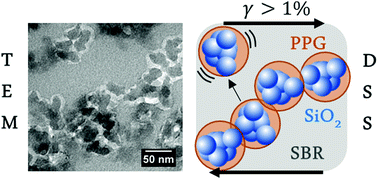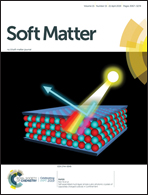Isostructural softening of the filler network in SBR/silica nanocomposites†
Abstract
A new formulation of the widely used nanocomposites based on SBR (ca. 250 kg mol−1) and fractal silica fillers is proposed by substituting the usual covering and coupling agents with short chains (4 kg mol−1) of polypropylene glycol (PPG). We study in a systematic way the structural evolution and the changes in the linear and non-linear mechanical properties of two series of samples varying: (i) the silica volume fraction (Φsi = 0, 5, 10 and 15 vol%) in PPG-free samples and (ii) the amount of PPG for a given silica content Φsi = 15 vol%. While the first series is used as a reference, showing expected trends (e.g. the enhancement of the plateau modulus), the second series reveals in contrast, a surprising PPG insensitivity, both in terms of the filler structure (investigated by means of SAXS, SEM and TEM) and properties “at rest” (linear rheology). However, increasing the strain amplitude (both in shear and tensile tests) discloses the great effect of the oligomers, opening possibly the way to a fruitful decorrelation between the low and high deformation performances of tires. Although this study is limited to the investigation of uncrosslinked materials, it will be extended to more operative industrial formulations in due course.



 Please wait while we load your content...
Please wait while we load your content...